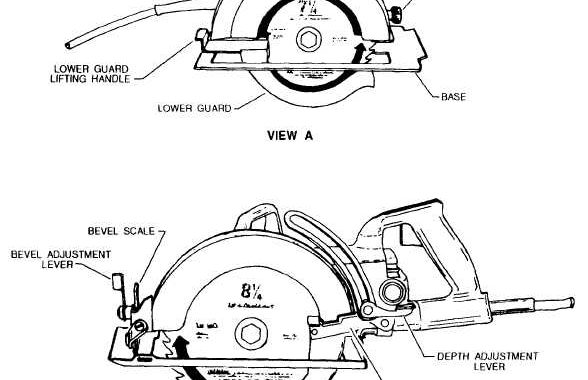Circular Saws (Download)
CIRCULAR SAWS Source: http://www.osha.gov/SLTC/etools/machineguarding/saws/handheld_saws.html 1 What is a Circular Saw? A circular saw is a motor-powered cutting tool which utilizes a circular spinning cutting blade, typically with a toothed edge Electric Battery Gas (not common) Source: http://www.osha.gov/SLTC/etools/machineguarding/saws/handheld_saws.html 2 Parts of a Circular Saw Source: http://www.tpub.com/content/construction/14043/css/14043_55.htm 3 Blades Typical blade diameter: 4”-12” Typical speed: 4000-8000 rpm Applications: wood, metals, & plastics (masonry is better cut with wet saws) 4 Blade Types Toothed Blades Wood-cutting (crosscut, ripping, combination) Fiber cement-cutting Aluminum/Plastic-cutting Non-Toothed Blades Masonry-cutting Tile-cutting Metal-cutting 5 History England (1777) Samuel Miller patented the circular sawing machine powered by a windmill Harvard, MA (1813) Tabitha Babbitt was inspired by the spinning wheel to invent the first circular saw for use in a saw mill Source: http://www.wooden-box-maker.com/women-in-woodworking.html Source: http://www.yorksaw.com/blog/history-of-the-circular-saw 6 Safety Concerns Machine hazards Point of operation Fast moving rotary blade In-running nip points (pinch points) Kickbacks Flying chips/material Tool projection Electrical hazards 7 NCBI Study Of 266 circular saw injuries, the following was found: 125 of the injuries were to only one finger Probability of injury increases in the digits closest to the thumb side of the hand No significant difference in left or right hand injuries Multiple finger injuries were found to most likely be diagonal cuts rarely resulting in amputation Amputation was more frequent in single digit injuries Only a few of the 3-5 finger injuries resulted in complete amputation Source: http://www.ncbi.nlm.nih.gov/pubmed/7158079 8 Fatality Example A worker was using a gas driven circular saw to cut a clay sewer line and was struck and cut by the tool when it “kicked back” after cutting the pipe. The saw flipped into the air and cut the right side of the employee’s neck resulting in a fatal injury. Source: Extracted from OSHA Accident Investigation Data 1990-2009 9 Fatality Example A worker was operating a hand-held circular saw with the trigger choked in the ‘on’ position and the blade guard missing. He lost control of the saw and it struck his leg. He bled to death on the way to the hospital. Source: Extracted from OSHA Accident Investigation Data 1990-2009 10 Applicable OSHA Regulations §1926.300 (d3) Circular saws shall be equipped with a constant pressure switch that will shut off power when pressure is released. §1926.304 (b) (b) Operating speed must be permanently marked on circular saws over 20” in dia. § 1926.304 (d) All portable power-driven circular saws shall be equipped with guards above and below the base plate or shoe. 11 PPE Safety glasses with side shields Face shield Respirator or dust mask when exposed to dust Earplugs or earmuffs 12 When using a circular saw, DO: Check the retracting lower blade guard to make certain it works freely Ensure that the blade is sharp enough for the material Check the saw for proper blade rotation Set the depth of the blade while the saw is unplugged so that the lowest tooth does not extend more than about 1/8” (0.3 cm) beneath the wood Keep all cords clear of cutting area 13 DO: Use two hands to operate saws – one on a trigger switch and the other on a front knob handle Keep motor free from accumulation of dust and chips Select the correct blade for stock being cut and allow it to cut steadily; do not force it Secure stock being cut to avoid movement Keep eyes on the saw while in use Support material lengthwise when ripping slender material 14 DO NOT: Place hand under the shoe or guard of the saw Hold or force the retracting lower guard in the open position Over-tighten the blade-locking nut Twist the saw to change, cut, or check alignment Use a saw that vibrates or appears unsafe in any way Force the saw during cutting 15 DO NOT: Cut materials without first checking for obstructions or other objects such as nails and screws Carry the saw with a finger on the trigger switch Overreach – keep proper footing and balance Rip stock without using a wedge or guide clamped or nailed to the stock Remove guard or prop open 16 Think Safety Work Safely 17

